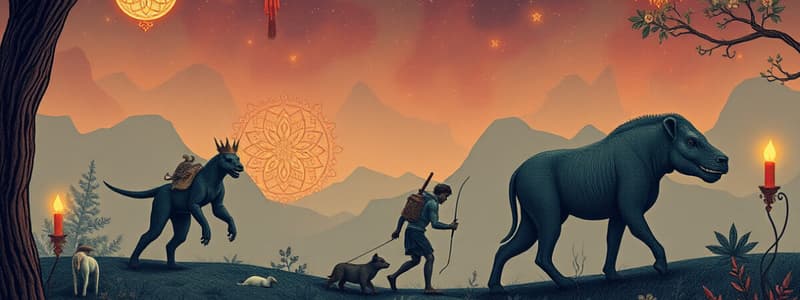Podcast
Questions and Answers
What marked the transition from hunting and gathering to farming in human evolution?
What marked the transition from hunting and gathering to farming in human evolution?
- Use of fire for cooking
- Creation of tools
- Introduction of agriculture (correct)
- Development of art
The Iron Age preceded the Bronze Age in human history.
The Iron Age preceded the Bronze Age in human history.
False (B)
What were some of the large mammals that early humans hunted during the Paleolithic period?
What were some of the large mammals that early humans hunted during the Paleolithic period?
Woolly mammoths, deer, and bison
During the _________ period, humans began living more permanently in villages due to the introduction of agriculture.
During the _________ period, humans began living more permanently in villages due to the introduction of agriculture.
Match the following archaeological periods with their characteristics:
Match the following archaeological periods with their characteristics:
What is the earliest period of the Stone Age?
What is the earliest period of the Stone Age?
Early humans in the Mesolithic period used complex stone tools for hunting.
Early humans in the Mesolithic period used complex stone tools for hunting.
What creative expression did ancient humans leave behind during the Paleolithic period?
What creative expression did ancient humans leave behind during the Paleolithic period?
Which of the following advancements occurred during the Bronze Age?
Which of the following advancements occurred during the Bronze Age?
During the Iron Age, iron was less valuable than gold.
During the Iron Age, iron was less valuable than gold.
What was the primary material used for clothing in the Bronze Age?
What was the primary material used for clothing in the Bronze Age?
The ______ Age followed the Bronze Age and was characterized by the discovery of ways to heat and forge iron.
The ______ Age followed the Bronze Age and was characterized by the discovery of ways to heat and forge iron.
Match the following developments with their respective ages:
Match the following developments with their respective ages:
Which ancient civilization is notably recognized for building pyramids during the Bronze Age?
Which ancient civilization is notably recognized for building pyramids during the Bronze Age?
The first written accounts, such as Egyptian hieroglyphs, emerged during the Iron Age.
The first written accounts, such as Egyptian hieroglyphs, emerged during the Iron Age.
What type of dwelling became common during the Bronze Age?
What type of dwelling became common during the Bronze Age?
Flashcards are hidden until you start studying
Study Notes
Prehistoric Period Overview
- Human evolution spans only a fraction of Earth's 4.5 billion-year history, with the Prehistoric Period dating from 2.5 million years ago to 1,200 B.C.
- Categorized into three main archaeological periods: Stone Age, Bronze Age, and Iron Age.
The Stone Age
- Divided into Paleolithic (Old Stone Age), Mesolithic (Middle Stone Age), and Neolithic (New Stone Age).
- Paleolithic Period (2.5 million years ago to 10,000 B.C.): Early humans lived as hunters and gatherers in caves or simple structures, using basic stone and bone tools.
- Controlled fire was utilized for cooking prey like woolly mammoths, deer, and bison.
- First examples of art emerged, including engravings with natural materials and the creation of small figurines from various materials.
- Marked by the end of the last Ice Age, leading to climate change and the migration of humans.
- Mesolithic Period (10,000 B.C. to 8,000 B.C.): Development of small polished stone tools and increased nomadic lifestyles, often living near water bodies.
- Introduction of agriculture led to more permanent settlements and the establishment of villages.
- Neolithic Period (8,000 B.C. to 3,000 B.C.): Transition from hunting/gathering to agriculture; domestication of animals and cultivation of crops.
- Advancements in tool-making, home construction, and artistic expressions such as pottery, sewing, and weaving.
The Bronze Age
- Lasted from about 3,000 B.C. to 1,300 B.C., characterized by significant metalworking advancements with the creation of bronze, an alloy of copper and tin.
- Bronze was used to produce stronger weapons, tools, and innovations like the ox-drawn plow and the wheel.
- Architectural evolution included the potter’s wheel and the construction of roundhouses with thatched roofs.
- Emergence of organized governance, law, warfare, and early religious practices, particularly in ancient Egypt, known for pyramid construction.
- Earliest examples of written communication, including Egyptian hieroglyphs, also appeared during this period.
The Iron Age
- Spanning approximately 1,300 B.C. to 900 B.C., this era began with advancements in heating and forging iron.
- Iron became more valued than gold, leading to mass production of iron tools and weapons, which were more accessible than bronze.
- Architectural developments included complex four-room homes and fortifications, alongside the emergence of royal palaces and temples.
- The rise of early city planning introduced paved streets and water infrastructure.
- Increased sophistication in agriculture, art, and religion, along with the advent of writing systems and alphabets, marked the transition into the Early Historical Period.
Studying That Suits You
Use AI to generate personalized quizzes and flashcards to suit your learning preferences.




